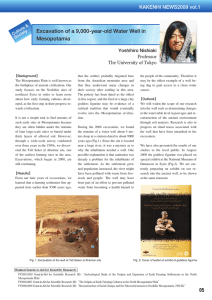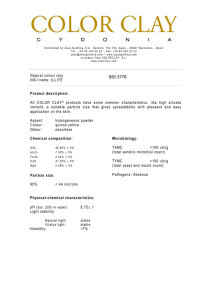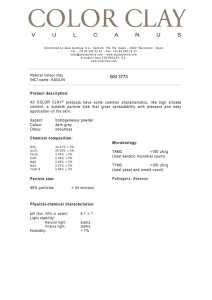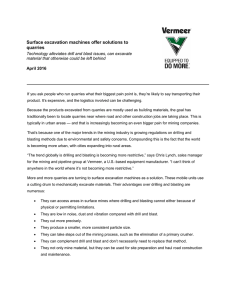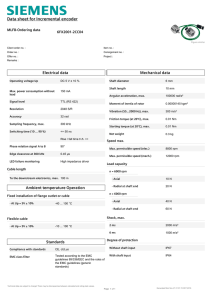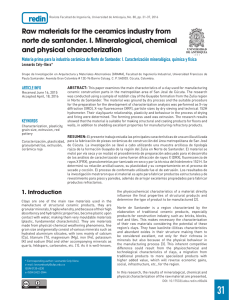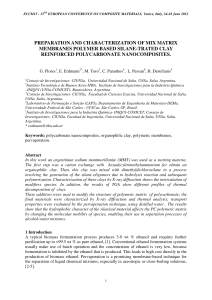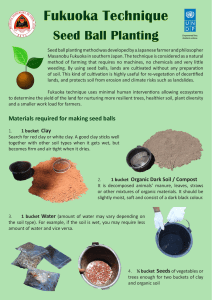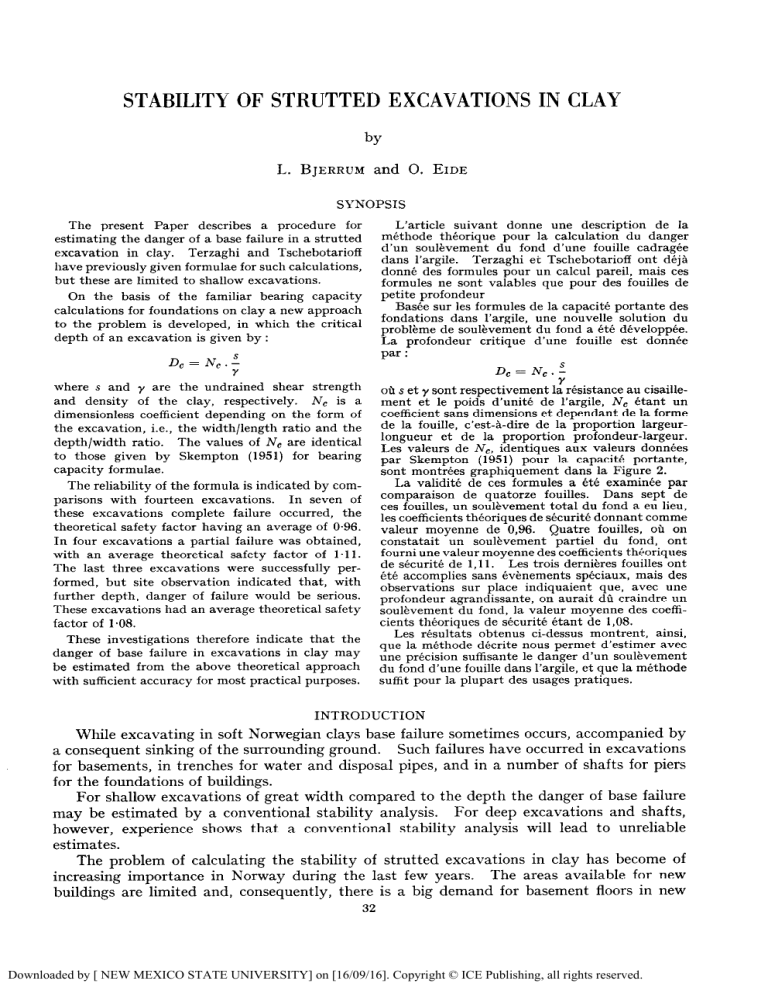
STABILITY OF STRUTTED EXCAVATIONS IN CLAY bY L. BJERRUM and 0. EIDE SYNOPSIS The present Paper describes a procedure for estimating the danger of a base failure in a strutted excavation in clay. Terzaghi and Tschebotarioff have previously given formulae for such calculations, but these are limited to shallow excavations. On the basis of the familiar bearing capacity calculations for foundations on clay a new approach to the problem is developed, in which the critical depth of an excavation is given by : DC= NC.2 L’article suivant donne une description de la methode theorique pour la calculation du danger d’un soulevement du fond d’une fouille cadragee dans l’argile. Terzaghi et Tschebotarioff ont deja donne des formules pour un calcul pareil. mais ces formules ne sont valables que pour des fouilles de petite profondeur BasCe sur les formules de la capacite portante des fondations dans l’argile, une nouvelle solution du probleme de soulevement du fond a 6th developpee. La profondeur critique d’une fouille est don&e par : D, = NC. : Y where s and y are the undrained shear strength and density of the clay, respectively. NC is a dimensionless coefficient depending on the form of the excavation, i.e., the width/length ratio and the depth/width ratio. The values of NC are identical to those given by Skempton (1951) for bearing capacity formulae. The reliability of the formula is indicated by comparisons with fourteen excavations. In seven of these excavations complete failure occurred, the theoretical safety factor having an average of 0.96. In four excavations a partial failure was obtained, with an average theoretical safety factor of 1.11. The last three excavations were successfully performed, but site observation indicated that, with further depth, danger of failure would be serious. These excavations had an average theoretical safety factor of 1.08. These investigations danger of base failure be estimated from the with sufficient accuracy therefore indicate that the in excavations in clay may above theoretical approach for most practical purposes. Y oh s et y sont respectivement 1: resistance au cisaillement et le poids d’unite de I’argile. Ne Ctant un coefficient sans dimensions et dependant de la forme de la fouille, c’est-a-dire de la proportion largeurlongueur et de la proportion profondeur-largeur. Les valeurs de N,, identiques aux valeurs donnees par Skempton (1951) pour la capacite portante, sont montrees graphiquement dans la Figure 2. La validite de ces formules a Cti: examinee par comparaison de quatorze fouilles. Dans sept de ces fouilles, un soulevement total du fond a eu lieu, les coefficients theoriques de securite donnant comme valeur moyenne de 0.96. Quatre fouilles, oh on constatait un soulevement partiel du fond, ont fourni une valeur moyenne des coefficients thcoriques de securite de 1,ll. Les trois dernieres fouilles ont Cti: accomplies sans Bvenements speciaux, mais des observations sur place indiquaient que, avec une profondeur agrandissante, on aurait dh craindre un soulevement du fond, la valeur moyenne des coefficients theoriques de securite &ant de 1,OS. Les resultats obtenus ci-dessus montrent, ainsi, que la methode d&rite nous permet d’estimer avec une prCcision suffisante le danger d’un soulevement du fond d’une fouille dans I’argile, et que la methode suffit pour la plupart des usages pratiques. INTRODUCTION While excavating in soft Norwegian clays base failure sometimes occurs, accompanied by Such failures have occurred in excavations a consequent sinking of the surrounding ground. for basements, in trenches for water and disposal pipes, and in a number of shafts for piers for the foundations of buildings. For shallow excavations of great width compared to the depth the danger of base failure For deep excavations and shafts, may be estimated by a conventional stability analysis. however, experience shows that a conventional stability analysis will lead to unreliable estimates. The problem of calculating the stability of strutted excavations in clay has become of The areas available for new increasing importance in Norway during the last few years. buildings are limited and, consequently, there is a big demand for basement floors in new 32 Downloaded by [ NEW MEXICO STATE UNIVERSITY] on [16/09/16]. Copyright © ICE Publishing, all rights reserved. STABILITY OF STRUTTED EXCAVATIONS IN CLAY 33 structures. Again, the increasing use of floating foundations for buildings on soft clay has posed the problem of estimating the danger of failure in the excavations for the basements. Finally, the stability problem has become of particular importance in Oslo, in connexion with the design of a subway through the town centre. The Norwegian Geotechnical Institute commenced work on this problem shortly after its establishment in 1952. This work has consisted mainly of collecting case records of base failures, together with a theoretical treatment of the problem. The results of this work are presented in the present Paper, and a comparison is made between field experience and theoretical analysis. METHOD OF CALCULATION The problem to be treated is confined to the stability of excavations which are sufficiently strutted to prevent horizontal displacements of the walls. Furthermore, only temporary excavations are considered ; that is, no attention is directed to changes in shear strength of the clay which, in permanent excavations, may occur with time. During removal of the clay shear stresses are set up underneath an excavation, since the weight of the surrounding soil masses will tend to press the clay towards, and up into, the excavation. If the shear strength of the clay is sufficient to withstand the imposed shear stresses, then the excavation is stable. If, however, the shear strength of the clay is smaller than the applied shear stresses, the bottom of the excavations will be forced upwards and the soil masses on one or several sides of the excavation will sink vertically. The problem is thus one of stability, the solution of which requires a consideration of the direction of movement and the extent of the failure zone. In the literature, this stability problem was discussed by Terzaghi (1943), later by Terzaghi and Peck (1948), and by Tschebotarioff (1951). Terzaghi, as shown in Fig. 1, considers a clay mass alongside the excavation as exerting a certain pressure on the clay on a plane level with the bottom of the excavation. The bearing Fig. 1. Calculation of excavation Terzaghi (1943) of the stability according to capacity qf is calculated by the usual methods, and for an excavation of great length compared to the width the following equation is applicable : qf = 5.7s where s is the undrained shear strength pf the clay (assumed to be saturated). When calculating the pressure applied by the surrounding mass to a plane level with the bottom of the excavation, Terzaghi considers a section of clay of width i 1/s, this width being Downloaded by [ NEW MEXICO STATE UNIVERSITY] on [16/09/16]. Copyright © ICE Publishing, all rights reserved. 34 L. BJERRUM AND 0. EIDE determined by the position of the failure zone. The weight of the clay block is reduced by the shear strength D . s on the plane of section. Thus the vertical stress is : where y is the density of the clay. When the excavation reaches the depth where failure occurs, then : Pv = 9f Thus the critical depth D, of the excavation is given by : D, = 5.7s . . . . . . . . (1) Tschebotarioff’s considerations are in principle similar to those of Terzaghi, assuming only a different shape of the failure zone. He also considers the ratio,of the length L to the breadth B of the excavation, and his expression for the critical depth is :’ (2) On the basis of observations from excavations in Oslo where bottom heave has occurred, it can be stated that Terzaghi’s equation (1) gives a reliable estimate of the stability of an excavation, provided that (a) the width of the excavation is large compared with the depth, and (b) the clay is comparatively homogeneous with no stiff upper layer (weathering crust). In cases of deep excavations, where the ratio depth/width is great, or in cases where the surface clay has a stiff drying crust, equation (1) gives unreliable results. In other words, failure occurs at considerably smaller depths than indicated by equation (1) ; and corresponding divergencies between theory and field observations are found with Tschebotarioff’s equation (2). These divergencies can be explained by shortcomings of the theoretical assumptions regarding the shape of the failure zone. Both equations (1) and (2) assume a circular sliding surface underneath the bottom of the excavation, and that this surface extends vertically up to the ground surface. The formulae thus assume that the shear strength of the clay is fully mobilized right up to the surface. For very deep excavations this assumption will not hold true. Underneath a deep excavation, such as a shaft., for a pier, failure will occur without fully mobilizing the shear strength of all the upper clay layers. In order to obtain a reliable estimate of the stability of deep excavations it is thus necesAn exact sary to consider the danger of local failure below the bottom of the excavation. treatment of this problem is not possible at present since the necessary plasticity theory is not available. The calculation of the bearing capacity of foundations, however, presents a corresponding problem, for which a satisfactory approximate solution has recently been found. The solution of this problem may be applied to the calculation of the stability of excavations. The bearing capacity of a footing on clay is expressed by the equation : qf = yD + IV,. s . . . . . . . . . (3) where qf = the bearing capacity of the footing, . Y = the density of the clay, undrained shear strength of the clay, S D z depth of footing, N, = coefficient depending on the shape and depth of the footing. For foundations of great width compared to the depth, NC may be calculated by assuming Downloaded by [ NEW MEXICO STATE UNIVERSITY] on [16/09/16]. Copyright © ICE Publishing, all rights reserved. STABILITY OF STRUTTED EXCAVATIONS IN 35 CLAY that the sliding surface is extended up to the ground level. For shallow footings NE will thus increase approximately linearly with depth. If the depth of the foundation is increased NC will, however, not increase correspondingly. When the depth exceeds about three times This is because, when a deep footing is loaded to the breadth NC will remain constant. failure, a local failure zone will be produced underneath the footing and the surrounding soil masses will be pressed aside without mobilizing the full shear strength of clay in the upper layers. The value of NC will thus remain constant for depths greater than about three times the width of the footing. A complete discussion of the problem of calculating the bearing capacity of deep foundations was given by Skempton (1951). In this Paper he mentions the investigations carried out by Meyerhof and Wilson, but his main treatment is based on a calculation method developed by Bishop, Hill, and Mott for metals and later extended by Gibson to include clays. According to this treatment, failure is caused under a deep circular footing by the formation of a spherical plastic zone underneath the footing whilst the surrounding clay remains in an elastic state. For this case NC, Gibson derives the equation : ,=$log;+l] +l where E is the elastic modulus of the clay for undrained deformation. E may be obtained from the inclination of the stress/strain curve of the clay, determined by unconfined compression tests. For ordinary clays, the ratio E/s varies between 50 and 200. This corresponds to a variation of N, from 7.6 to 9.4. In the sensitive Norwegian clays, E/s will vary between 100 and 200 and N, will consequently vary between 8.5 and 9.4. On the basis of all existing theoretical determinations and a number of model tests, Skempton finally sums up the present knowledge of this problem by giving a diagram showing NC as a function of the depth and the shape of the foundation. This diagram is shown in Fig. 2. A comparison between calculated and observed bearing capacities has confirmed the reliability of this diagram, although loading tests seem to indicate that the values for NCmay be slightly conservative.for sensitive Norwegian clays (Bjerrum, 1955). Professor Skempton pointed out to the Authors in 1952, that it was probable that the above calculation method for the bearing capacity of foundations may, without any adaptations, be used to calculate the stability of excavations ; in fact, the two problems are analogous. In the first case we have to determine the additional load which, at a certain depth, will cause failure in the clay. In the second case, the question is to what limit the clay, by an excavation, may be unloaded before failure occurs. As the shear stresses in the two cases simply have opposite signs, one can directly derive from equation (3) the following expression for the critical depth of excavation : D,=N,s Y . . . . . . . . . . More generally the safety factor against base failure may be expressed by the equation : F=N$rD+q ’ ’ ’ * * * ’ * . (5) where F = the safety factor, D = the depth of the excavation, y = the density of the clay, = the undrained shear strength of the clay in a zone underneath and immediately S around the bottom of the excavation, p = the surface surcharge, NC = a coefficient depending upon the dimensions of the excavation. Downloaded by [ NEW MEXICO STATE UNIVERSITY] on [16/09/16]. Copyright © ICE Publishing, all rights reserved. L. 36 BJERRUM AND 0. EIDE D B 1 p = depth of excavation = width of excavation = length of excavation = surcharge = undrained shear strength S y = density of clay NC = coefficient F = safety factor circular or square, of clay B/l - I.0 9 8 7 6 5 4 I I I I I I 2 3 4 5 rectanyu~ar - D/B Nc Fig. 6 (0.84+0.16 s/l).Ncyua~ 2. The critical depth of excavations calculated on the basis of the bearing Values of NC from capacity theory. Skempton (1951). As a working hypothesis the above-mentioned analogy is assumed to be so complete that the NC-values for the bearing capacity of footings on clay may be directly used in equations (4) and (5). But the accuracy of this theory must be investigated by field observations. Indeed, one cannot ignore the fact that the NC-values for an excavation may differ from those in Fig. 2, the latter being valid for the calculation of the bearing capacity of a rigid foundation with uniform deformations, whereas the deformations at the bottom of an excavation may take place freely and therefore will be greater in the middle of the excavation than along the edges. The reliability of the above theory is investigated by field observation from fourteen deep excavations, given in the following examples. Downloaded by [ NEW MEXICO STATE UNIVERSITY] on [16/09/16]. Copyright © ICE Publishing, all rights reserved. STABILITY EXAMPLES OF STRUTTED OF COMPLETE EXCAVATIONS FAILURES IN IN 37 CLAY EXCAVATIONS Pumping station, Fmnebu, Oslo A typical example of base failure occurred in October 1954 during the excavations for a sewage tank in OxenGvegen, Fornebu, Oslo. The dimensions of the excavation were 5 x 5 m and it was designed to be excavated to a depth of 3.20 m below ground level. The excavations were made within heavy wooden sheet piling, with tongue and groove connexions. The sheet piling itself was securely strutted. As the work proceeded the excavated soil was removed from the vicinity of the excavation so that no surface surcharge loads were acting. When the excavation reached a depth of 3.0 m (Fig. 3) a total failure occurred. The bottom rose about O-5 m and there was a simultaneous sinking of the surrounding ground of ,- G.I. be&e Fohre piling De th OF excovotion Per Mure OF Depth OF excovobon betbre &lure -%%t- Fig. 3. -*-, Rock *-%a. Pumping Station, Fornebu, Oslo about 1 m on that side where the ground was at its highest. Furthermore, cracks appeared in the ground around the excavation. Apart from small displacements the sheet piling remained intact during the heave. Shortly after the failure field investigations were carried out by the Norwegian Geotechnical Institute. Four vane borings were made around the excavation, and one in the middle. Furthermore, in one boring undisturbed samples were taken for detailed laboratory investigations. Underneath a fill of thickness 0.4-0.7 m there was a relatively stiff and dry clay crust down to about 1.4 m below ground level. Vane borings and samples showed that below this crust there was a layer of very soft and very quick clay which went down to rock, which was found at a depth of 3-9 m below ground level. The shear strength of the quick clay was nearly constant throughout the depth and equalled 0.75 ton/sq. m. A vane boring performed in the excavation showed that the clay was completely disturbed to a depth of 2-2.5 m below the bottom of the excavation. A stability calculation indicated an NC-value of 7.0 corresponding to a safety factor of 1-O. The theoretical value corresponding to a depth/width ratio of the excavation equal to 060 is 7.2. When the failure occurred the theoretical safety factor was thus 1.03. Downloaded by [ NEW MEXICO STATE UNIVERSITY] on [16/09/16]. Copyright © ICE Publishing, all rights reserved. 38 L. BJERRUM AND 0. EIDE Store house, Drammen A failure occurred during the excavation for a store house in Drammen in August 1954, just before the required depth of excavation of 2.5 m had been reached. Further work proved to be fruitless and the basement floor was abandoned since, with further excavation, clay masses were forced up in the bottom of the excavation. The work was performed by a mechanical excavator, leaving the sides of the excavation vertical and not strutted. In spite of the bottom heave the unstrutted sides remained intact and vertical. Furthermore, there was no appreciable sinking of the ground immediately around the excavation, but at a distance of 4-5 m from the work marked cracks and settlements were observed. The continued excavation after the base failure had occurred led to considerable sinking of a nearby road fill about 1.5-2.0 m high. According to earlier field investigation of this area the ground may be described as having a firm clay crust down to a depth of 2 m. Underneath this crust was a layer of very soft and very sensitive clay. Rock was found to a depth of 6-7 m. The shear strength of the clay was, to a depth of 3-4 m, 1.0-1.6 ton/sq. m. The average value of the shear strength was estimated to be 1.2 ton/sq. m. The weight of the excavator together with other loads amounted to a surcharge of approximately 1.5 ton/sq. m. As the density of the clay was 1.9 ton/cu. m, the coefficient N, will be 5.1 for a critical depth of excavation of 2.4 m. The depth/width ratio was approximately 0.5, leading to a theoretical NC-value of 5.9. The calculated safety factor was thus 1.16. Such a high figure may possibly be explained by the load from the nearby road filling, but it is difficult to consider this factor in the calculation. Pier shaft, Nordenskioldsgatan, Giiteborg In 1930 a block of flats was built in Nordenskioldsgatan in Gdteborg. The building was founded on steel piles driven down to rock. The structure was built on a slope with a comparatively steep gradient, and that may be the reason for the slow creep which has been observed in the slope. Shortly after the building was completed horizontal movements were observed, causing cracks and other damage in the building. In 1954 the damage had become so comprehensive that the building had to be pulled down. A new building on the same site was designed, but this time the foundations were to be piers down to rock. Circular pier shafts were excavated to rock at a depth of 25 m. Sheet piling, strutted by concrete rings, was successively .driven down as excavating proceeded. At the surface the shaft had a diameter of 1.30 m, this diameter decreasing gradually to 0.90 m at the rock. The foundation work was, on the whole, successfully performed in the above manner. Only one pier shaft had to be abandoned because of base failure. In this shaft the excavation had almost reached the rock at a depth of 25 m. At this point the rock sloped steeply. Just before the failure occurred the distance down to the rock was approximately O-3 m on one side of the shaft and 1.3 m on the other. The workman who was in the excavation relates that the bottom rose so quickly that he only just managed to climb up before the clay masses reached him. The bottom rose about 5 m, and repeated attempts to complete the excavation failed since, when further clay was removed, new clay masses continued to flow into the shaft. Field investigations carried out in connexion with the planning of the building showed the existence of clay layers from ground level down to rock. The top layer was a post-glacial clay containing some organic matter, whereas the bottom layer was a marine clay of high sensitivity (St = 20-50). The water content of the clay decreased from about 80% in the upper layer to about 55% at a depth of 20 m. The average density of the clay was 1.54 ton/cu. m. The undrained shear strength increased linearly with depth. Underneath a weathering crust 3-4 m thick Downloaded by [ NEW MEXICO STATE UNIVERSITY] on [16/09/16]. Copyright © ICE Publishing, all rights reserved. Downloaded by [ NEW MEXICO STATE UNIVERSITY] on [16/09/16]. Copyright © ICE Publishing, all rights reserved. STABILITY OF STRUTTED EXCAVATIONS IN CLAY 39 the shear strength was 1.5 ton/sq. m, increasing to approximately 3.5 tons/sq. m at a depth of 20-25 m. As the depth of excavation was 25 m when failure occurred, the total overburden at the bottom of the excavation was 38.5 tons/sq. m. The shear strength of the clay being 3.5 tons/sq. m, N, will in this case be 11. According to the theory for the D/B ratio of 28, an NC-value of 9.0 is indicated. The high actual value of NC may be partly due to the close proximity of the rock surface to the bottom of the excavation. Sewage tank, Drammen During the construction of a nursing-home in Drammen in August 1952, a failure occurred in the excavation for a sewage tank. The dimensions of the excavation were 5.5 x 8.0 m, with a designed depth of 4.5 m. Down to a depth of 3.5 m, a stiff clay was encountered, but as soon as the underlying soft, quick clay was reached the bottom of the excavation started to rise, and continued during the subsequent attempt to complete the excavation. The excavation was not braced, and in spite of the bottom failure the walls of the upper stiff clay remained intact and vertical. Several attempts to complete the excavation within sheet piles driven well below the final depth proved to be unsuccessful, and only after the removal of the upper soil layers surrounding the excavation was the intended depth reached. Soil investigations carried out after the failure showed that below an upper drying crust there was a soft, quick clay of shear strength approximately 1 ton/sq. m, with a density of 1.8 tons/cu. m. Based on the collected data an NC-value is calculated for the conditions immediately before the first failure, which took place at a depth of 3.5 m. A surcharge of 1 ton/sq. m on the surface around the excavation was taken into account. The result of this calculation is that NC should be 7.2 to obtain the safety factor 1.0. The theoretical value is 6.7, but it is emphasized that this excellent agreement between observation and theory may be somewhat fortuitous since there are some uncertainties in the estimate of the shear strength and the surcharge. Test shaft (N), EnsjBveien, Oslo In connexion with the design of a new subway in Oslo, three trial shafts were excavated in 1953for the purpose of determining the reliability of the theoretical analysis of the stability of excavations. For all three shafts thorough soil investigations were made including sampling, vane tests, and pore pressure measurements. During the excavation large samples were cut out at different depths for a detailed laboratory investigation. At different stages of the excavation vane tests were made from the bottom in order to investigate possible changes in shear strength of the clay. The excavation was started by digging a lG1.5 m-deep circular hole with a diameter just exceeding 1.5 m. A number of 1.5-m C$rings, made by welding 30-mm C$ steel bars, were placed in the bottom of the hole and 2-in. timber planks were driven down as sheet piles outside the rings. The sheet piles were driven successively as the clay was excavated, splicing each plank to the preceding one as they were driven into the ground. The rings were lowered in steps each time leaving the top ring behind. In this way the rings were distributed along the shaft at a distance of 0.5 m from each other, thus forming a regular support for the sheet piles (Fig. 4). The northern shaft (N) was excavated through 1.5 m of fill and then through 2 m of stiff drying crust. Below the drying crust a soft-and in parts a very soft-quick clay was enThe quick clay continued down to a depth of lo-11 m, and from this depth, countered. continuing down to rock at a depth of 15 m, was a sandy clay. The shaft (N) was terminated at a depth of 7 m, at which point failure was expected. The Downloaded by [ NEW MEXICO STATE UNIVERSITY] on [16/09/16]. Copyright © ICE Publishing, all rights reserved. 40 L. BJERRUM Depth in metres Fig. 4. AND fi 0. EIDE Sheur shwgth Test shaft (N), Ensjiiveien, Oslo. Cross-section after failure failure did not occur, however, until two weeks after the excavation had been completed. The bottom rose about 2 m and, as shown in Fig. 5, a sinkhole appeared in the ground close to the sheet piling. Two vane tests carried out after the failure showed that the clay was remoulded to 19-1.5 m below the original shaft bottom. The clay below the bottom of the shaft had a shear strength of 1.2 ton/sq. m, and the average density of the soil was 135 ton/cu. m. A calculation based upon these values shows that NC should be 10.8 in order to obtain the safety factor 1.0. This is 20% in excess of the theoretical value. Excavation, Grey Wedels Plass, Oslo In 1913 a total failure occurred in an excavation in Oslo. The excavation was 5.8 x 8.1 m in area and was designed to reach a depth of 5 m, but a base failure took place at a depth at 4.5 m. Even after the driving of heavy sheet piling the bottom continued to rise as the clay was removed. The work was finally completed by excavating small sections which were covered with concrete and then loaded. Investigations carried out in 1954 by the Norwegian State Railways showed the soil to consist of a soft clay. The shear strength of the clay layer from 4.5 m-at which depth the failure took place-down to 7.5 m was determined, by vane tests, to be 1.4 ton/sq. m. A calculation of the stability of the excavation immediately before failure led to a safety factor of 1.08. A surcharge loading of approximately 1 ton/sq. m due to building materials was included in the calculation. Downloaded by [ NEW MEXICO STATE UNIVERSITY] on [16/09/16]. Copyright © ICE Publishing, all rights reserved. STABILITY OF STRUTTED EXCAVATIONS IN CLAY 41 “ Kronibus ” shaft, Tyholt During the last war the German occupation authorities started the construction of a railway tunnel in clay near Trondheim (Hartmark, 1955). A German contractor, who was supposed to be a specialist, made an attempt to sink a 20-m-deep shaft midway on the tunnel length. At this site the soil consists of a very sensitive clay. When the shaft had reached a depth of 19.7 m a failure occurred and the shaft was partly filled with liquid clay. The work was thereupon abandoned and the tunnel was not completed until after the war, when it was built by the shield-driving method. The dimensions of the shaft were 2.7 x 4.4 m. The shear strength of the clay at the bottom of the shaft was approximately 3.5 tons/sq. m, as determined by vane tests carried out by the Norwegian State Railways. The density of the clay was 1.8 ton/cu. m. A calculation of the stability indicates a theoretical safety factor of 034. The N,-value which gives a safety factor of 1.0 is 10.1, compared with the theoretical value &5.* EXAMPLES OF PARTIAL FAILURES IN EXCAVATIONS Pumping station, Jernbanetorget, Oslo In 1943 a deep excavation was made for a pumping station in Oslo. During the work a movement in the surrounding ground was experienced, and Mr S. Skaven-Haug, civil engineer of the Norwegian State Railways, was consulted. His report, and additional information required for the calculations, was placed at the disposal of the Norwegian Geotechnical Institute. The dimensions of the excavation were 12.2 x 8.5 m with an intended depth of about 9 m below ground level. The top 2.5 m of the excavation was strutted, and from this depth slender and unsatisfactory sheet piles about 10 m long were driven. When the excavation reached a depth of 6.3 m below ground level cracks appeared around the hole at a distance of about 8-10 m, i.e., at a distance relatively large compared with the depth. Mr Skaven-Haug explained the cracks as being caused by movements in the underlying clay masses, following slight base failure in the excavation. A complete failure did not occur. The existing struts were strengthened, and the work was completed by the excavation of small sections which were then loaded by casting the base of the footing. Site investigations were made in advance by a private firm, and vane tests to a depth of 19 m were carried out by the Norwegian Geotechnical Institute in 1952. Under 2 m of fill, soft to medium-firm clay was encountered to great depth. The shear strength of the clay as determined by vane tests was about 2-3 tons/sq. m, the lowest values being experienced at a depth of about 12 m below ground level. The shear strength near the bottom of the excavation, when the cracks occurred, was about 2.2 tons/sq. m. The average density of the clay was 1.9 ton/cu. m. For a failure at a depth of 6.3 m an NC-value of 5.5 may be expected. A calculation according to the above theory indicates an NC-value of 6.9. This means that deformations occurred at a depth at which the calculated safety factor is 1.25. It is probable that the excavation could have been deepened without total failure occurring. The critical depth according to the theory is about 8 m. Store house and o&e block, A/S Freia, Oslo During the summer and autumn of 1954, excavations were dug for a new store house in Oslo. The building was supported partly by steel piles to rock, and partly it rested directly The present Authors suggest that the effect of * The theoretical NC-value 8.5 is Skempton’s value. For shafts the width/length ratio on the NC-value may be questioned as far as deep shafts are concerned. with depth/width as well as depth/length ratios greater than 4 (see Fig. 2) it may be that the theoretical NC-value should be 9 instead of 8.5 as used in this case. Downloaded by [ NEW MEXICO STATE UNIVERSITY] on [16/09/16]. Copyright © ICE Publishing, all rights reserved. 42 L. BJERRUM AND 0. EIDE on the rock, which was encountered at depths varying from 5-20 m below ground level. The depth to rock, of interest in the present Paper, was about 9 m at a side wall, where the rock sloped somewhat towards the centre of the building. The depth of excavation was about 5 m, as shown in Fig. 6. II @npmry excovotion 5 Fig. 6. Store house, A/S Freia, Oslo. Cross-section through excavation The work was carried out with a side slope of 1 : 1 to a depth of 0.5 m above the required depth. At this stage a small slide occurred in the side slope, but this had no effect on the underlying clay. The excavation was widened to vertical walls in small sections, which were strutted. After the sides were strutted and the piles driven, the foundations for the outside walls and columns were cast. Excavation of the remaining 0.5 for the basement, and the casting of the basement floor, was carried out after completion of the walls, columns, and ground floor of the building. The placing of the foundation and walls up to ground-floor level, and also a little higher, was completed by May 1955, and then work on the basement commenced. Before the casting of the basement floor the remaining 05 m was excavated and at that time a settlement of the ground outside the wall was noticed. The gable wall of a single-storey brick workshop without a basement was situated about 3 m from the side wall. The gable wall had settled slightly during the first part of the excavation, but the settlements increased noticeably with the excavations for the basement, to an extent of about 10 cm. Cracks were noticed on the ground, and the settlement near the side wall was less than that near the gable wall. Those settlements, and the cracks, indicated that the safety factor against base failure in the basement was very small, and the basement slab was cast as soon as possible. The Norwegian Geotechnical Institute carried out two vane borings and took samples before the excavation commenced. The top 3 m consisted of a hard weathering crust and, under that, the shear strength of the clay decreased with depth to a minimum value of 1.4 ton/sq. m at a depth of 6 m, and then increased to 2.5 ton/sq. m at a depth of 10 m. Downloaded by [ NEW MEXICO STATE UNIVERSITY] on [16/09/16]. Copyright © ICE Publishing, all rights reserved. STABILITY OF STRUTTED EXCAVATIONS IN CLAY 43 At a depth of 5 m, with a density of clay of 1.9 ton/cu. m, together with a surcharge load of 0.5 ton/sq. m due to the workshop, the pressure was 10 tons/sq. m. The average shear strength of the clay was 1.6 ton/sq. m, which gave an NC-value of 6.25 at that depth. The excavation was very long compared to the width, and since the depth to rock was limited the depth/breadth ratio was approximately equal to 1.0 which gave a theoretical NCvalue of 6.4 with a safety factor of only 1.02. Shaft, Shellhaven, England In connexion with the construction of a pumping station at Shellhaven, in the Thames Estuary clays, a shaft of 55 m dia. was excavated and, at a depth of 5.2 m, a slight failure occurred. Messrs John Mowlem kindly supplied the relevant facts and gave permission for their publication in this Paper. The excavation was supported by cast-iron rings. A total failure was not experienced and it was thought that the work could possibly have proceeded a further O-5 m. But a movement of the surrounding ground had been noticed and, for safety, the work was stopped for a while, and then completed under air pressure. Site investigations have been described by Skempton and Ward (1952) and Skempton and Henkel (1953) in connexion with adjacent works at Shellhaven. Under a hard brown clay a soft-to-fairly-soft sensitive clay is found, with occasional layers of peat and silt. The shear strength of the clay in the vicinity of the bottom of the shaft at the depth of 5.2 m is about 1.6 ton/sq. m. The pressure due to the clay mass, together with a surcharge load of 1 ton/sq. m, gives a pressure of about 9 tons/sq. m at the base of the excavation. The average shear strength of the clay being 1.6 ton/sq. m, NC-values of 5.6 and 6.1 are obtained, corresponding to depths of 5.2 and 5.7 m. According to theory, an NC-value of 7.5 and a critical depth of 7.6 m are indicated. A comparison between the theoretical values and the field experience indicates that a partial failure occurred when the safety factor was 1.34. Part of this divergence between theory and practice may be explained by the decrease in shear strength due to remoulding at the bottom of the shaft. Test shaft, Siirligaten, Oslo In a similar manner to the test shaft at Ensjoveien a test shaft was excavated near the tunnel at Sorligaten, Oslo. Here also, extensive site investigations, including vane borings and samplings, were performed, and several blocks of the clay were obtained for laboratory investigations. The shaft is shown in Fig. 7. The ground conditions may be described as follows. Under a 1*5-m-thick top layer of fill, silt is encountered to a depth of 3 m, and then a fairly sensitive clay is found to a depth of 10 m, the shear strength of which decreases from 4 tons/sq. m to l-5-2 tons/sq. m. At a depth of 9-11 m the clay contains some sand and gravel, and below this-to rock at 17 mis a quick clay of shear strength about 2 tons/sq. m. Excavation proceeded to a depth of 13 m without failure. Tests performed during the work showed a decrease in the shear strength of the clay underneath the bottom of the shaft when a depth of 12 m was reached. That may be considered as the critical depth, as the decrease in the shearing strength was due to large shear deformations. The decrease in shear strength could be seen very clearly from a vane boring carried out, after the excavation, about 0.5 m away. That local failure did not, however, lead to a complete failure. At a depth of 12 m the shear strength of the clay is 2.1 tons/sq. m and, with an average density of 1.85 ton/cu. m, an NC-value of 10.6 is obtained. The depth/diameter ratio for the shaft is 8.0 and the theoretical NC-value is 9, giving a safety factor of 0.85. Downloaded by [ NEW MEXICO STATE UNIVERSITY] on [16/09/16]. Copyright © ICE Publishing, all rights reserved. 44 L. BJERRUM AND 0. EIDE Depth in metres P’wood piles - 5 3Omm q steel rinys - Sheor drenglh be/&e cxcadan L?.--_ - Sheur a/&y% uFhzr CXCOVOtIM Test shaft, Siirligaten, Fig. 7. Oslo In spite of the partial failure at a depth of 12 m it was possible to excavate to a depth of 13 m where the safety factor is 0.75. It is possible that total failure was retarded by the relatively hard top layer preventing the development of deformations. EXAMPLES Basement excavation, Storgaten OF SUCCESSFUL EXCAVATIONS 5, Oslo In the summer of 1952 a 6-7-m-deep excavation for two basement floors was made in the central part of Oslo. The excavation was carried out in sections within sheet piles, and as soon as a section was excavated concrete was placed and loaded with sand. Careful soil investigations were made by the Norwegian Geotechnical Institute. The shear strength of the soft and partly quick clay was 1.75 ton/sq. m and the density was 1.9 ton/cu. m. The depth to rock was 13-15 m. The above data are valid for the place where the most critical section was excavated. The dimensions of that section were 8 x 4 m and the depth was 6.7 m. Corresponding to the depth/width ratio of 1.7, the theoretical NC-value is 8.0. The safety factor is thus only 1.10. During the excavation careful observations were made, including an attempt to measure the rise of the bottom of the excavation. Those measurements proved to be very difficult, and were only partly successful. From the results it was, however, concluded that the bottom of the critical section rose about 2 cm. The excavation was situated close to neighbouring buildings and some settlements and cracks of secondary importance were observed. Downloaded by [ NEW MEXICO STATE UNIVERSITY] on [16/09/16]. Copyright © ICE Publishing, all rights reserved. STABILITY Subway OF STRUTTED EXCAVATIONS IN CLAY 45 in Chicago One of the examples used by Tschebotarioff (1951) in his treatment of the problem was a deep excavation for the Chicago subway. A detailed description of the work and of the site conditions is given by Peck (1943), but it must be remarked that Peck does not direct attention to the question of stability. At one particular point in the subway the excavation was 16.0 m wide and 11.3 m deep. The excavation was strutted, but a maximum horizontal deformation of 6 cm occurred. During excavation a maximum heave of 10 cm was observed together with a sinking of the adjacent ground of about 3-15 cm, the largest values being nearest the excavation. Although a complete failure did not occur it is clear that the safety factor was low. The clay underneath the excavation had, according to Tschebotarioff, a shear-strength of 3.5 tons/sq. m. A calculation of the stability of the excavation shows a theoretical N,-value of 6.1 with a safety factor of 1.0. Test shafts (S), Ens$ueien, Oslo ,4s described earlier, two test shafts were excavated at Ensjoveien, Oslo, in the summer of 1953. Whilst a total failure was obtained in the northern shaft, the southern shaft was excavated to a depth of 11 m, which was not sufficient to produce failure. The dimensions and method of excavation of the test shafts have already been described. The shear strength of the clay at the bottom of the shaft was 2.7 tons,sq. m, the average density of the clay was 1.93 tonjcu. m, the depth/diameter ratio was 7.3, and a theoretical S,-value of 9.0 was obtained. The theoretical safety factor was 1.11. The test shaft was kept open for 12 months without any sign of failure. The data of the investigated excavations are summarized in Table 1, which also gives the factors of safety against base failure calculated by the proposed method. From the data presented in Table 1 the following conclusions may be drawn : (1) The theoretical safety factor for the se\-en cases in which complete failure occurred varies between 032 and 1.16. The average value is 0.96. The field observations therefore confirm the reliability of the theoretical analysis, and the accuracy with which the observed total failures could have been predicted by this method is considered to be satisfactory. (2) Also the four excavations in which pavtial failures were observed support the theoretical approach, since the calculated safety factors vary between 035 and 1.25 with an average of 1.11. (3) The three successful excavations are selected cases in which the safety factors against base failure are judged to be small. The theoretical safety factors of these cases vary between 1.0 and 1.14 with an average value of 1.08. If compared with the field observations made during the excavations, the calculated safety factors are believed to give a correct evaluation of the stability. It is very likely that a further excavation of the two cases which show the lowest safety factors would have led to failure. (4) Included among the excavations with a total or partial base failure are four shafts It is immediately seen from Table 1 that great depth compared to the width. the safety factors of these four shafts are remarkably low compared with the The safety factors of the four shafts vary between 0.82 and 0.85 other cases. with an average of 0.84. These results may be explained by a too low theoretical W,-value for deep excavations, and it is thus possible that Skempton’s IV,-values, which are confirmed by field observations of foundation failures or loading tests of Downloaded by [ NEW MEXICO STATE UNIVERSITY] on [16/09/16]. Copyright © ICE Publishing, all rights reserved. 46 L. BJERRUM Table Data concerning 1. Pumping station, Fornebu, 0. EIDE 1. instability of excavations 1 Oslo 2. Storehouse, Drammen .4KD 5.0 Y 5.0 ~ 3.0 0.0 1.75 0.60 ! 1 7.2 1 1.8 Y u3 / 2.4 ~ I.5 ~1% 3. Pier shaft, GGteborg 4 04 4. Sewage tank, Drammen 5.5 x 8.0 , 25.0 0.0 3.5 1.0 1.03 Total failure 1.16 11.54 3.5 i 20~~50~1.0 ~28.0 ~ 9.0 I ~1.80 ~1.0 20 ~0.69 10.64 6.7 0+X2 0.93 5. Test shaft (S), EnsjGveien, Oslo 6. Excavation, Grev Vedels pl., Oslo ___~ 7. “ Kronibus shaft,” Tyholt, Trondheim --_ 8. Pumping station, Jernbanetorget, Oslo -__ 9. Storehouse, Freia, Oslo i j I 5.8 x s.1 ~12.2 x 8.5 5.0 Y cc --____ 11. Test shaft, Sijrligaten Oslo : 14. Test shaft (S), Ensjdveien, Cslo 19.7 0.0 1 ,SO 1.4 5510 0.72 ~0.78 1 7.0 ~ 10.61 ~7.3 1.80 3.5 40 6.3 0.0 1.6 12 0.0 11.00 I 6.4 1.02 6 1.o : 095 ! 7.5 1.34 60 1.0 ~f+()(J1 ~ 9.0 10-20 0.5 1.40 I i 10. Shaft, Shellhaven 13. Subway, Chicago 1.0 I - 12. Basement excavation, Storgaten Oslo I 4.5 ‘-_- 2.7 X 4.4 I .$5.5 41.5 ; ~8.0 x 4.0 / i 16~~ 5.0 0.0 j.2 14 1.90 i 1.54 1.61 I I 12.0 ~ 04 ~1.85 2.1 6.7 i 0.0 ~I.90 1.75 3.5 I ’ do. do. 1 j do. ~ 0+?5 ~ No ~ ~_ 1.70 s.0 i 1.10 failure 0.0 ~0.70 6.1 1.00 j do. 1.14 d(,. I I 4 1.5 11.0 0~0 1 1.93 2.7 1 200 / 1.0 7.30 / 9.0 on English clays, are somewhat smaller than the values valid for the sensitive Norwegian clays with a high value of E/s. A better agreement would result if NC was assumed to be 10 for deep shaft excavations instead of 9. The observations made during excavation of the test shaft in Sijrligaten indicate, however, another explanation of the low safety factors of the deep shafts. This test shaft proved that under certain conditions it is possible to excavate a shaft to a greater depth than that calculated theoretically without obtaining a total failure. If a shaft is dug through a stiff clay down to soft clay, the upper stiffclay layer will prevent, at least for a time, a local overstressing of the soft clay below the bottom of the shaft from extending to a total failure. This effect of an upper stiff-clay layer was observed in the test shaft in Siirligaten which was excavated down to almost 2 m below the calculated critical depth. Moreover, Downloaded by [ NEW MEXICO STATE UNIVERSITY] on [16/09/16]. Copyright © ICE Publishing, all rights reserved. STABILITY OF STRUTTED EXCAVATIONS IN CLAY 47 this effect may explain why the Iota1 failure in the test shaft (N) at Ensjiiveien occurred a certain time after the excavation was completed. (5) The scattering of the calculated safety factors for some of the excavations seems to indicate that the danger of failure will increase if the excavation is not sufficiently braced to prevent excess horizontal deformations. If the upper clay layers are stiff, and the depth of the excavation is small, the danger of a base failure seems to be less affected by the bracing. (6) Experience cannot yet indicate exactly how much the danger of a base failure is The stabilizreduced if sheet piles are driven below the bottom of an excavation. ing effect of sheet piling seems, however, to be small for the cases where the shear strength of the clay does not increase with depth. XCKXOWLEDGEMENTS Four of the described fourteen case records were collected by Mr Skaven-Haug, chief engineer of the Norwegian State Railways. The Authors are indebted to Mr Skaven-Haug for permission to use and publish his field observations. The Authors are, moreover, indebted to the Planning Office for Suburban Lines and Subways, Oslo, whose support made it possible to excavate the three test shafts. The Authors also wish to express their particular gratitude to Professor A. W. Skempton and to Dr A. W. Bishop for valuable discussions on the problem, and to the Directors of John Mowlem & Company for permission to use and publish the Shellhaven case records. Finally, the Authors acknowledge the assistance of their colleagues, especially the work done by Mr I. Johannessen, during the laboratory and field investigations. REFERENCES BJERRUM, L., 1955. Stability of Natural Slopes in Quick Clay. Gtotechnique, 5 : 101. Proc. 1st Int. Conf. Soil Mrch. (Cambridge), CUEVAS, I. A., 1936. Foundation Conditions in Mexico City. 3 : 233. HARTMARK, H., 1955. Geotekniske Observasjoner fra utfdrelsen av Tyholdt Jordtunnel. Teknisk Ukeblad, 27 : 565. JANBU, N., 1952. Stabilitet av skjaeringer i apen sjakt. Norges Geotekniske Institutf. Int. r@ort F 13, OSLO. PECK, R. B., 1943. Earth pressure measurements in open cuts, Chicago (Ill.) subway. Trans. Amer. Sot. Civ. Eqrs, 108 : 1008. Sldg Res. Cong., London, 1951. Papers preSKEMPTON, A. W., 1951. The Bearing Capacity of Clays. sented in Div. 1. DD. 180-189. SKEMPTON,A. W., and WARD, W. H., 1952. Investigations Concerning a Deep Cofferdam in the Thames Estuary Clay at Shellhaven. Giotechnique, 3 : 119. SKEMPTON. A. W., and HENKEL, D. J., 1953. The Post-glacial Clays of the Thames Estuary at Tilbury and Shellhaven. Proc. 3rd Int. Conf. Soil Mech. (Zurich), 1 : 302. TERZAGHI, I<., 1943. Theoretical soil mechanics. W&y, Niw York. TERZAGHI, I<., and PECK, R. B., 1948. Soil mechanics in engineering practice. Wiley, New York. TSCHEBOTARIOFF,G. P., 1951. Soil mechanics, foundations, and earth structures. McGraw-Hill, New York. Downloaded by [ NEW MEXICO STATE UNIVERSITY] on [16/09/16]. Copyright © ICE Publishing, all rights reserved.
